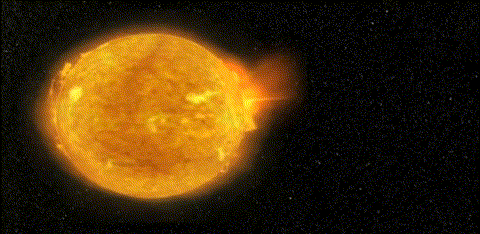You don’t have to be a Doctor to work in Medical Industries and you don’t have to be a Soldier to work in Military Industries. Do you have a dream to enter Aerospace, Medical, or Military Industries, even though you are an Electromagnetic Compatibility (EMC) expert?
Well, it is actually possible for an EMC expert to enter the Aerospace, Medical, or Military Industries.

Video 1: shows the effect of Electromagnetic Interference when a new machine with an inverter-fed drive system is added near an existing reliable functional machine [6].
EMC has a wide range of applications, in this blog, we will discuss briefly about the importance of EMC in the Aerospace Industry.
In space, there are several types of electromagnetic waves. For instance, due to solar flares, eruptions, and coronal mass ejection from the Sun, harmful electromagnetic waves will be created which will affect the safety of satellites and other spacecrafts, leading to system failures, power cuts, and communication disruptions on Earth as shown in Video 2 and 3.

Video 2: shows how the coronal mass ejections from our sun emit harmful waves followed by masses of charged particles and how the studies showed that monitoring these waves provides early warning of incoming charged particles that may cause disruptions in power and communication networks [7].
An Aerospace System should be capable enough to operate in presence of an Electromagnetic Environment (EME). In other words, in order to ensure proper operation and to minimize risk to space programs, Aerospace systems are required to meet EMC requirements. Its operation is confirmed by EMC testing if the system is designed for its EME. The EME can be determined by studying the life cycle history and testing in its respective realistic environment for realistic and cost-effective designs.
In 1997 [1] proposed a method of developing EME from the LCEP (Life Cycle Environmental Profile) and SDP (System Development Process). Further [1] also proposed the standard EME requirements, environmental tailoring, various EMC testing, and Standard Environmental Testing Methodology called “POP OI POP”. These methodologies helped to develop enhanced future standards which have been implemented successfully in Aerospace System.

Video 3: shows how the visions from the SOHO satellite helped scientists study and understand sunspots that are associated with solar flares and eruptions harmful to satellites, astronauts and communications here on earth [8].
In 2008 [2], to minimize the risk to space programs with respect to EMC, a standard was established for space-related systems which is called SMC Standard SMC-S-008 [3]. This is the standard that has been developed employing several known standards with an intention to improve and to know the testing parameters for space applications. The most commonly used testing standard is MIL-STD 461, which is specific to both radiated & conducted emissions and susceptibility.
NASA has defined vehicles as airborne and space-borne assemblages of units and subsystems which will operate together to provide payload support functions and to launch space assets [2]. Not only the Aerospace system vehicles, even their interfaces such as space vehicle interfaces, launch vehicle interfaces, launch site interfaces, payload interfaces, ground support equipment interfaces, test equipment interfaces, and ordnance interfaces must meet all these EMC requirements [2].
Contemporarily there are several new developments in standards based on the complicated designs in Aerospace Industry. Since 1997 these standards have been updated regularly in order to catch up with the technological development in Aerospace Industry. The most recent standard is SMC Standard SMC-S-025 [4], which has been tailored in 2019 to SMC Tailoring SMC-T-008 [5].
In this blog, we discussed the very brief importance of EMC in the Aerospace Industry. There is still a lot to know about this humongous intriguing field.
References
[1] R. Prasad, “The role of EMI/EMC testing in the development of aerospace systems,” Proceedings of the International Conference on Electromagnetic Interference and Compatibility ’99 (IEEE Cat. No. 99TH 8487), 1997, pp. 133-140, doi: 10.1109/ICEMIC.1997.669785.[2] Jack Black, “EMC and Aerospace – In Compliance Magazine”, July 1, 2010.
[3] Air Force Space Command, Space and Missile Systems Center Standard “EMC Requirements for Space Equipment and Systems”, SMC Standard SMC-S-008, June 13, 2008.
[4] Air Force Space Command, Space and Missile Systems Center Standard “EMC Requirements for Space Equipment and Systems”, SMC Standard SMC-S-025, July 26, 2017.
[5] Air Force Space Command, Space and Missile Systems Center Tailoring “EMC Requirements for Space Equipment and Systems”, SMC Tailoring SMC-T-008, March 06, 2019.
[6] YouTube, “Electromagnetic compatibility (EMC) – How to protect your machinery / plant from EMI”, icotek (Channel Name), April 6, 2020.
[7] YouTube, “Tour of the EMS 01 – Introduction”, ScienceAtNASA (Channel Name), March 6, 2010.
[6] YouTube, “Tour of the EMS 08 – Gamma Rays”, ScienceAtNASA (Channel Name), May 25, 2020.
About the Author: Arunkumar Hunasanahalli Venkateshaiah
 Arunkumar Hunasanahalli Venkateshaiah accomplished his Master’s degree with few months of Student Research Assistant experience in Electrical Systems Engineering with a focus on Electronics and Devices at the University of Paderborn in Germany, 2019. In India, he finished his Bachelor’s degree in Electrical and Electronics Engineering at Visvesvaraya Technological University, EWIT Bengaluru.
Arunkumar Hunasanahalli Venkateshaiah accomplished his Master’s degree with few months of Student Research Assistant experience in Electrical Systems Engineering with a focus on Electronics and Devices at the University of Paderborn in Germany, 2019. In India, he finished his Bachelor’s degree in Electrical and Electronics Engineering at Visvesvaraya Technological University, EWIT Bengaluru.


